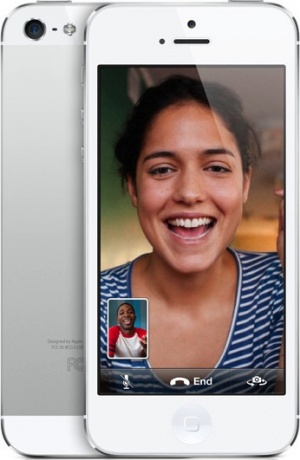Difference between revisions of "FaceTime"
| Line 26: | Line 26: | ||
*iPod touch (4th generation) or later | *iPod touch (4th generation) or later | ||
*Mac with Mac OS X v10.6.6 or later | *Mac with Mac OS X v10.6.6 or later | ||
| + | |||
| + | ==History== | ||
| + | When FaceTime was announced, it was wifi-only and at first only on Apple's also-new iPhone 4. During this announcement, Former Apple CEO Steve Jobs mentioned that Facetime would be an open video calling standard, and that they would open up the standard for anybody to use. <ref>[http://www.reuters.com/article/2010/06/08/urnidgns852573c4006938800025773c006633b-idUS168083514520100608 FaceTime Open Standard.] Retrieved 2012-12-09</ref> | ||
==Ethical Implications== | ==Ethical Implications== | ||
| − | + | Before the introduction of [[iOS]] 6, it was rumored that AT&T would start charging users for FaceTime over their 3G network.<ref>[http://www.theverge.com/2012/7/17/3164208/at-t-may-charge-for-facetime-calls-over-3g/in/3024812 AT&T may charge for FaceTime] Retrieved on 2012-12-09.</ref> After the introduction of the new software, AT&T revealed that FaceTime would only be allowed on their 3G network for customers of their Mobile Share plans. <ref>[http://www.theverge.com/2012/8/17/3250228/att-facetime-over-cellular-ios-6-mobile-share/in/3024812 AT&T Allowing 3G FaceTime with Mobile Share] Retrieved 2012-12-09.</ref> This distinction was called into question by several "net neutrality" watchdog groups, who then petitioned the FCC. <ref>[http://www.theverge.com/2012/9/18/3351626/att-facetime-block-fcc-complaint-net-neutrality/in/3024812 Groups Petition FCC] Retrieved 2012-12-09.</ref> The FCC responded to these complaints, saying they would review the objections. <ref>[http://www.theverge.com/2012/9/25/3404938/fcc-julius-genachowski-att-facetime/in/3024812 FCC Reviews Objections] Retrieved 2012-12-09</ref> On November 8th 2012, AT&T revealed that they would be expanding mobile network usage of FaceTime to users with LTE devices on tiered data plans, but other users would still need to be on Mobile Share plans. They also revealed that they would be rolling out FaceTime over cellular to customers on more data plans in the "near future" but did not specify further. <ref>[http://www.theverge.com/2012/11/8/3619034/at-t-loosens-facetime-restrictions-allows-iphone-5-users-to-video/in/3024812 AT&T loosens restrictions] Retrieved 2012-12-09</ref> | |
Restricting this service calls into question the ethics of a service provider restricting certain kinds traffic and what that means for the competitive landscape. If a service provider prioritizes the traffic of one application over the other, people will probably just not use the application that is restricted and find other means. In this case, Apple may lose customers who would have used FaceTime to Skype or another video calling service. | Restricting this service calls into question the ethics of a service provider restricting certain kinds traffic and what that means for the competitive landscape. If a service provider prioritizes the traffic of one application over the other, people will probably just not use the application that is restricted and find other means. In this case, Apple may lose customers who would have used FaceTime to Skype or another video calling service. | ||
Revision as of 00:40, 10 December 2012
|
FaceTime is a VoIP (Voice Over IP) video calling service from Apple, Inc. It was first developed for use with the iPhone 4's front-facing camera and later made compatible with all iOS devices with front-facing cameras, as well as Mac computers running OS X with Facetime or iSight cameras.
How It Works
FaceTime is attached to a users phone number on their iPhone 4 or later, and an email address on all other supported devices. [1] Users can click a FaceTime button in their iPhone contact lists for anyone in their contacts who has registered with the service. On other devices, users can go from the contacts or the FaceTime application itself.
Supported Devices[2]
- iPhone 4 or later
- iPad 2 or later
- iPod touch (4th generation) or later
- Mac with Mac OS X v10.6.6 or later
History
When FaceTime was announced, it was wifi-only and at first only on Apple's also-new iPhone 4. During this announcement, Former Apple CEO Steve Jobs mentioned that Facetime would be an open video calling standard, and that they would open up the standard for anybody to use. [3]
Ethical Implications
Before the introduction of iOS 6, it was rumored that AT&T would start charging users for FaceTime over their 3G network.[4] After the introduction of the new software, AT&T revealed that FaceTime would only be allowed on their 3G network for customers of their Mobile Share plans. [5] This distinction was called into question by several "net neutrality" watchdog groups, who then petitioned the FCC. [6] The FCC responded to these complaints, saying they would review the objections. [7] On November 8th 2012, AT&T revealed that they would be expanding mobile network usage of FaceTime to users with LTE devices on tiered data plans, but other users would still need to be on Mobile Share plans. They also revealed that they would be rolling out FaceTime over cellular to customers on more data plans in the "near future" but did not specify further. [8]
Restricting this service calls into question the ethics of a service provider restricting certain kinds traffic and what that means for the competitive landscape. If a service provider prioritizes the traffic of one application over the other, people will probably just not use the application that is restricted and find other means. In this case, Apple may lose customers who would have used FaceTime to Skype or another video calling service.
References
- ↑ Using FaceTime Retrieved 2012-12-09
- ↑ Using FaceTime Retrieved 2012-12-09
- ↑ FaceTime Open Standard. Retrieved 2012-12-09
- ↑ AT&T may charge for FaceTime Retrieved on 2012-12-09.
- ↑ AT&T Allowing 3G FaceTime with Mobile Share Retrieved 2012-12-09.
- ↑ Groups Petition FCC Retrieved 2012-12-09.
- ↑ FCC Reviews Objections Retrieved 2012-12-09
- ↑ AT&T loosens restrictions Retrieved 2012-12-09

